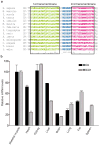A forty-kilodalton protein of the inner membrane is the mitochondrial calcium uniporter
- PMID: 21685888
- PMCID: PMC4141877
- DOI: 10.1038/nature10230
A forty-kilodalton protein of the inner membrane is the mitochondrial calcium uniporter
Abstract
Mitochondrial Ca(2+) homeostasis has a key role in the regulation of aerobic metabolism and cell survival, but the molecular identity of the Ca(2+) channel, the mitochondrial calcium uniporter, is still unknown. Here we have identified in silico a protein (named MCU) that shares tissue distribution with MICU1 (also known as CBARA1), a recently characterized uniporter regulator, is present in organisms in which mitochondrial Ca(2+) uptake was demonstrated and whose sequence includes two transmembrane domains. Short interfering RNA (siRNA) silencing of MCU in HeLa cells markedly reduced mitochondrial Ca(2+) uptake. MCU overexpression doubled the matrix Ca(2+) concentration increase evoked by inositol 1,4,5-trisphosphate-generating agonists, thus significantly buffering the cytosolic elevation. The purified MCU protein showed channel activity in planar lipid bilayers, with electrophysiological properties and inhibitor sensitivity of the uniporter. A mutant MCU, in which two negatively charged residues of the putative pore-forming region were replaced, had no channel activity and reduced agonist-dependent matrix Ca(2+) concentration transients when overexpressed in HeLa cells. Overall, these data demonstrate that the 40-kDa protein identified is the channel responsible for ruthenium-red-sensitive mitochondrial Ca(2+) uptake, thus providing a molecular basis for this process of utmost physiological and pathological relevance.
Conflict of interest statement
Figures




Comment in
-
Calcium: mitochondria channel calcium.Nat Rev Mol Cell Biol. 2011 Jul 13;12(8):463. doi: 10.1038/nrm3156. Nat Rev Mol Cell Biol. 2011. PMID: 21750571 No abstract available.
References
-
- Szabadkai G, Duchen MR. Mitochondria: the hub of cellular Ca2+ signaling. Physiology (Bethesda) 2008;23:84–94. - PubMed
-
- Carafoli E. Historical review: mitochondria and calcium: ups and downs of an unusual relationship. Trends Biochem Sci. 2003;28:175–181. - PubMed
-
- Berridge MJ, Bootman MD, Roderick HL. Calcium signalling: dynamics, homeostasis and remodelling. Nat Rev Mol Cell Biol. 2003;4:517–529. - PubMed
-
- Rizzuto R, Brini M, Murgia M, Pozzan T. Microdomains with high Ca2+ close to IP3-sensitive channels that are sensed by neighboring mitochondria. Science. 1993;262:744–747. - PubMed
Publication types
MeSH terms
Substances
Grants and funding
LinkOut - more resources
Full Text Sources
Other Literature Sources
Molecular Biology Databases
Miscellaneous

